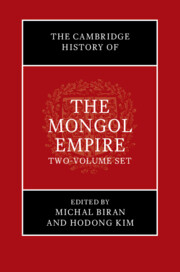Book contents
- The Cambridge History of the Mongol Empire
- The Cambridge History of the Mongol Empire
- Copyright page
- Dedication
- Contents
- Figures in Volume I
- Figures in Volume II
- Maps in Volume I
- Maps in Volume II
- Tables in Volume I
- Contributors to Volume I
- Contributors to Volume II
- Acknowledgments
- Notes on Dates and Transliterations
- Abbreviations
- Volume I
- Volume II
- Volume II Part 1 Literary Sources
- 1 Persian Sources
- 2 Chinese Sources
- 3 Mongolian Sources
- 4 Arabic Sources
- 5 Rus′ian-Language Sources
- 6 Western European Sources
- 7 Armenian Sources
- 8 Georgian Sources
- 9 Turkic and Chaghatay Sources
- 10 Tibetan Sources
- 11 Korean Sources
- 12 Syriac Sources
- 13 Uighur Sources
- 14 Greek Sources
- 15 Tangut Sources
- 16 Hebrew Sources
- Volume II Part 2 Archaeological and Visual Sources
- Index to Volume I
- Index to Volume II
- References
2 - Chinese Sources
from Volume II Part 1 - Literary Sources
Published online by Cambridge University Press: 01 January 2024
- The Cambridge History of the Mongol Empire
- The Cambridge History of the Mongol Empire
- Copyright page
- Dedication
- Contents
- Figures in Volume I
- Figures in Volume II
- Maps in Volume I
- Maps in Volume II
- Tables in Volume I
- Contributors to Volume I
- Contributors to Volume II
- Acknowledgments
- Notes on Dates and Transliterations
- Abbreviations
- Volume I
- Volume II
- Volume II Part 1 Literary Sources
- 1 Persian Sources
- 2 Chinese Sources
- 3 Mongolian Sources
- 4 Arabic Sources
- 5 Rus′ian-Language Sources
- 6 Western European Sources
- 7 Armenian Sources
- 8 Georgian Sources
- 9 Turkic and Chaghatay Sources
- 10 Tibetan Sources
- 11 Korean Sources
- 12 Syriac Sources
- 13 Uighur Sources
- 14 Greek Sources
- 15 Tangut Sources
- 16 Hebrew Sources
- Volume II Part 2 Archaeological and Visual Sources
- Index to Volume I
- Index to Volume II
- References
Summary
When the Mongols invaded China in the thirteenth century, China already had a long and sophisticated tradition of historical and bureaucratic writing; moreover, a large population of literate elites produced written records in great numbers and multiple genres. Chinese records, together with those in Persian, provide the largest trove of sources available for the Mongol Empire. These consist of transmitted sources, often reprinted in later centuries; stone inscriptions surviving from the Mongol era; and newly excavated sources. Genres include official histories, unofficial histories, bureaucratic documents, legal records, travelogues, contracts, miscellaneous notes, gazetteers, genealogies, encyclopedias, and other assorted literary output. Furthermore, Mongolian texts such as the Secret History of the Mongols are preserved in Chinese characters, used phonetically to represent Mongolian words. This chapter provides a comprehensive overview of these varied sources, organized roughly by genre.
Keywords
- Type
- Chapter
- Information
- The Cambridge History of the Mongol Empire , pp. 920 - 971Publisher: Cambridge University PressPrint publication year: 2023

